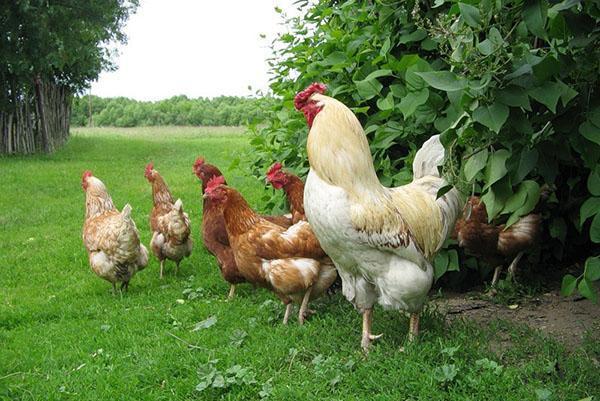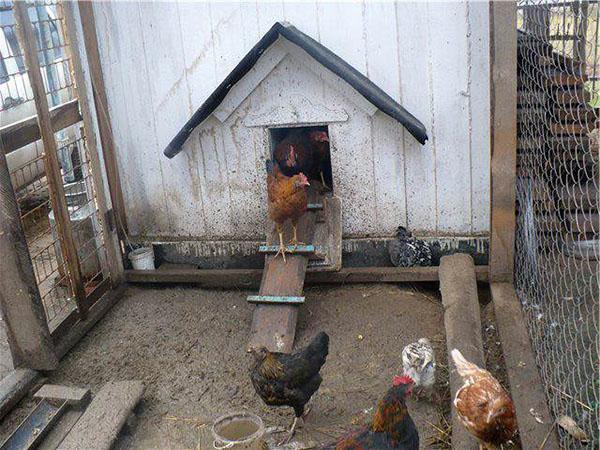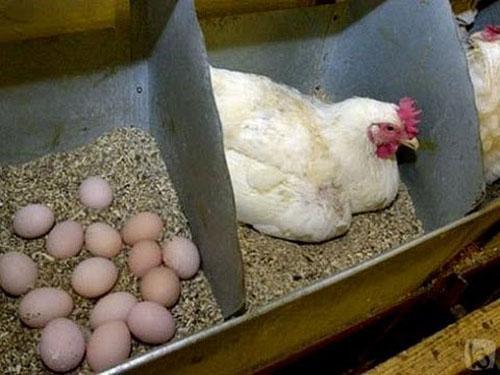Breeding chickens at home for beginners is an interesting and useful activity
 When a new lover of wildlife has mastered the garden, he will think about getting animal products. Breeding chickens at home for beginners is the first experience of commercial production of meat and eggs. Chickens are most tolerant of lack of grooming, almost omnivorous and friendly. This is an almost waste-free production - dung, eggs, meat, feathers - everything goes into business.
When a new lover of wildlife has mastered the garden, he will think about getting animal products. Breeding chickens at home for beginners is the first experience of commercial production of meat and eggs. Chickens are most tolerant of lack of grooming, almost omnivorous and friendly. This is an almost waste-free production - dung, eggs, meat, feathers - everything goes into business.
Livestock conditions

It is necessary to read the literature and determine the physiological norms of keeping and feeding chickens. Some facts about breeding conditions for chickens will need to be known in advance.
 For floor keeping, the room should have an area at the rate of 5 chickens per 1 square meter. The temperature of the content is not lower than 5-7 degrees. The room should be warm, light, dry, egg production depends on it. At night, regardless of the season, chickens should be indoors, equipped with perches. On the roost, each chicken should be 20 cm long and they should all be placed on the same level.
For floor keeping, the room should have an area at the rate of 5 chickens per 1 square meter. The temperature of the content is not lower than 5-7 degrees. The room should be warm, light, dry, egg production depends on it. At night, regardless of the season, chickens should be indoors, equipped with perches. On the roost, each chicken should be 20 cm long and they should all be placed on the same level.
In the cage, the bird develops faster, rushes and gains weight. 5-7 individuals are placed in one cage. A rooster in the herd is needed if fertilized eggs are needed in the future to incubate chicks. In summer cottage life, a rooster is needed for beauty and a flooded announcement of a new day.
A walking area for chickens is necessary, they must be in the fresh air. A shed is needed so that the herd can shelter from the rain.
For beginners, breeding chickens at home is important to determine the number and place of residence of the birds.
What breeds of chickens are suitable for home breeding
 Not all chicken breeds are suitable for backyard farming. Therefore, it is necessary to choose chickens for home breeding taking into account the specifics of the content, simple or thoroughbred. Simple ones are less demanding on the balance of feed, on keeping conditions. There are breeds of meat or egg orientation. So, meat broilers can be grown per season for full slaughter with a carcass weight of 3-4 kg. Egg breeds of chickens rush abundantly, but during the molting period they can be hammered, the soup will be rich. For a personal backyard, it is recommended to breed chickens of egg breeds:
Not all chicken breeds are suitable for backyard farming. Therefore, it is necessary to choose chickens for home breeding taking into account the specifics of the content, simple or thoroughbred. Simple ones are less demanding on the balance of feed, on keeping conditions. There are breeds of meat or egg orientation. So, meat broilers can be grown per season for full slaughter with a carcass weight of 3-4 kg. Egg breeds of chickens rush abundantly, but during the molting period they can be hammered, the soup will be rich. For a personal backyard, it is recommended to breed chickens of egg breeds:
- Russian whites;
- Red white-tailed;
- Leghorns
Got one day old chicks, what's next?
 You need to take a large warm box. Day-old chickens will knock on the wall with their noses, if it is cardboard or foam, they will prick and die. At the bottom, cover the bottom with newspapers, place a drinker and a feeder on them. Place an incandescent lamp on top of a tripod, adjusting the height so that there are 30 0C. The brood will be hindered at the bottom of the box and illuminated on the first day, even at night, later the daylight hours are reduced from 17 hours to 8.
You need to take a large warm box. Day-old chickens will knock on the wall with their noses, if it is cardboard or foam, they will prick and die. At the bottom, cover the bottom with newspapers, place a drinker and a feeder on them. Place an incandescent lamp on top of a tripod, adjusting the height so that there are 30 0C. The brood will be hindered at the bottom of the box and illuminated on the first day, even at night, later the daylight hours are reduced from 17 hours to 8.
Food and drink should always be available. Remove the pellet newspaper 2 times a day. If the chickens do "heap-small", they are cold, the lower ones can be crushed.If you are flattened away from the light, it is hot. From the fifth day, the temperature is reduced to 26 degrees and every week by 3 degrees more, so to 18. The chickens are transferred from the box to the litter, gradually increasing the area.
By the age of 4 months, the chicks are slightly smaller than an adult chicken in size, at 5 months they begin to rush.
Keeping chickens
 While the chickens were growing up in a cramped but warm room for the first two months, they built chicken coop... A chicken house can become a decoration of the estate. The main thing is that it should be without cracks so that there is no draft. The floor is covered with a thick layer of sawdust or straw.
While the chickens were growing up in a cramped but warm room for the first two months, they built chicken coop... A chicken house can become a decoration of the estate. The main thing is that it should be without cracks so that there is no draft. The floor is covered with a thick layer of sawdust or straw.
Feeders with three compartments are arranged:
- dry food;
- mineral supplements;
- mash.
The feeder should be separated by bar grids so the bird can peck rather than trample on the feed. Drinking bowl is installed separately. It is necessary to arrange an ash-sand bath in an old trough. By the time the hens ripen, nests should be prepared - deep boxes lined with dry grass with a depression. Install them in a secluded place at the rate of a nest for 3 hens.
For summer maintenance, the house can be built of plywood with a walk, fenced with a netting. For winter, you need an insulated, ventilated, heated room with electric lighting and a walking area. With good care, chickens fly in winter like in summer.
Chicken diet
 Any villager will tell you how to breed chickens at home. But one neighbor sells an excess of eggs all year round, while the other scolds her lazy people. Good care and a balanced bird feeding from birth.
Any villager will tell you how to breed chickens at home. But one neighbor sells an excess of eggs all year round, while the other scolds her lazy people. Good care and a balanced bird feeding from birth.
Chicks need water twice as much as feed. Therefore, the drinker must have fresh water. For the first time, diaries need to be given a 5% glucose solution to drink.
Fodder is poured onto pieces of cardboard until seven days old, then feeders are installed, preferably suspended. the first feeding for chicks consists of:
- fine grains crushed;
- hard boiled egg;
- dry fat-free cottage cheese.
Later, the egg is no longer given, the cottage cheese contains calcium, promotes plumage. From the second day, the addition of finely chopped greens to the feed is encouraged. In winter, when there is no clover, you can germinate cereals and add greens to the feed.
From day 3, the mash can be cooked in yogurt, meat broth. They feed only with a fresh mash, after an hour the leftovers are thrown away, the feeder is washed and rinsed with potassium permanganate. A weak pinkish solution of potassium permanganate should be fed to chickens in the morning twice a week. Five-day chickens already resilient. They gradually increase the amount of feed, add vitamins, fish oil, from the first day they need fine gravel, eggshells, coarse sand. Up to two months of age, only crushed cereals are used from cereals.
 Compound feed for an adult chicken it is necessary in the composition:
Compound feed for an adult chicken it is necessary in the composition:
- corn - 40%;
- wheat bran - 8%;
- barley flour - 20%;
- sunflower cake - 10%;
- fish meal, meat and bone meal 1: 1 - 10%;
- feed yeast - 3%;
- mineral additives, table salt - 5%.
Such a mixture in pure form and a mash is given 2-3 times a day. For good work of the stomach, be sure to feed the chickens with dry grain, it is better if the film on oats and rye is less.
A homemade egg always tastes different from a factory egg due to a variety of feed. The presence of carotene contributes to the orange color, this is due to the large amount of vitamin greens in the diet of layers.
 You cannot overfeed the laying hen, it will be difficult for her to carry, the insides will become fat. The eggs will begin to cover with a thin film instead of the shell, pour out, contaminating the nest. This circumstance will allow the birds to learn the taste of the product, and biting will begin in the future.
You cannot overfeed the laying hen, it will be difficult for her to carry, the insides will become fat. The eggs will begin to cover with a thin film instead of the shell, pour out, contaminating the nest. This circumstance will allow the birds to learn the taste of the product, and biting will begin in the future.
You need to feed the hen:
- mash - 65-75 g;
- dry grain mixture - 30-45 g;
- sprouted cereals - 10-12 g;
- root vegetables - 20-25 g;
- fish oil, yeast, gravel, shell 1-2 g each
You can add leftovers from the table to the feed, diversify the menu. The more ingredients in the feed, the tastier the egg.The menu depends on the season. However, if you visit the base, then chickens can eat vitamins all year round - often withered greens and fruits are thrown into waste containers. Chickens especially like mangoes and oranges.
The golden age of laying hens is up to 15 months, later it rushes less often, the meat coarsens. By this time, a new brood of chickens will be ready - this is how chickens are bred in a courtyard. Usually the first eggs of pullets are brought at the age of 110-120 days.
Signs of disease
 It is necessary to warn, for beginners, breeding chickens at home, know the main signs diseases... Despite good hygienic conditions, pigeons, stealing food, and rodents can bring the disease. Sick birds can be seen immediately. They are lethargic, do not go to the trough, do not stand up, convulsions are observed. A sick bird must be immediately separated from the flock.
It is necessary to warn, for beginners, breeding chickens at home, know the main signs diseases... Despite good hygienic conditions, pigeons, stealing food, and rodents can bring the disease. Sick birds can be seen immediately. They are lethargic, do not go to the trough, do not stand up, convulsions are observed. A sick bird must be immediately separated from the flock.
Lethargy, lack of appetite is considered a sign of vitamin deficiency. Feed greens, irradiate with ultraviolet lamps, give fish oil and everything will work out. It is scarier to cope with chicken cannibalism. If a wound appears on the bird's body, it will attract the attention of the merchants. Therefore, the light in the hen house should not be bright, the muted and reddish color hides fresh wounds.
You need to be on the alert, expect pecking and understand the reasons for this ailment:
- chickens bite their fingers in the blood - it is hungry:
- pecking out the head - a hierarchy is being established;
- pecking of the cloaca - when it is inflamed from improper feeding;
- when the cloaca is inflamed and falls out from the socks of very large eggs;
- pluck feathers - there are few minerals in the feed;
- the presence of insects - feather eaters, lice, ticks.
How to keep chickens and have a productive flock is a multifaceted question.
I didn’t know that if the tail of chickens goes bald then it’s a lack of vitamin D